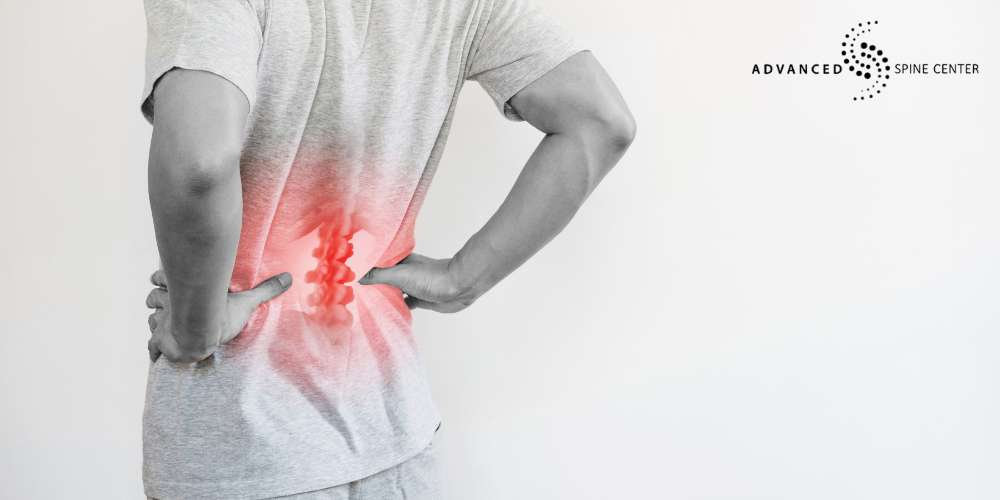Table of Contents
Disc desiccation is a condition in which the intervertebral discs in the spine are dehydrated or dried out. While it is a natural part of the aging process for people, it can also be associated with degenerative changes in the spine. If you’re suffering from back pain that may be due to disc desiccation, our team at the Advanced Spine Center is here for you. We are dedicated to enhancing our patients’ lives by prioritizing their health and well-being above all else. To schedule an appointment with a Plano orthopedic spine surgeon, please call our office at 972-499-5457 today.
Basic Anatomy of the Spine and Intervertebral Discs
A healthy spine consists of rectangular-shaped vertebrae, also known as spinal bones, stacked on top of each other. When these vertebrae stay properly aligned, the spine can maintain its natural curves and overall alignment.
The spine has natural curves in each of its main sections: cervical (neck), thoracic (middle/upper back), and lumbar (lower back). Maintaining these natural curves is crucial for the spine’s strength, flexibility, and ability to evenly absorb and distribute bodily stress during movement.
Between adjacent vertebrae are intervertebral discs, which play vital roles in spinal health. These discs cushion the vertebrae to reduce friction during movement, provide structural support by attaching to adjacent vertebrae, enhance spinal flexibility, and act as shock absorbers.
Because these discs perform so many essential functions, they are often the first spinal structures to show signs of damage in the early stages. When this happens, various problems can arise. Nearby spinal nerves can be affected if your spinal alignment is off and radiating pain. There are treatments you can try, such as epidural steroid injections.
Structure of the Spinal Discs
Our spinal discs are composed of two main components: a soft, gel-like inner nucleus and a tough, durable outer annulus. Intervertebral discs play a crucial role in our daily lives, providing both support and strength to our spines.
The outer portion of a disc is tough, circular, and made of concentric sheets of lamellae, which are collagen fibers that protect the inner core. Its inner nucleus contains a network of fibers suspended in a mucoprotein gel. The annular fibers of the outer shell hydraulically seal and protect the gelatinous fluid within while helping to evenly distribute force and pressure on the disc as a whole.
Each disc has cartilaginous end-plates on its outer annulus to which adjacent vertebrae attach, providing structure to the spine.
At birth, discs are composed of approximately 80 percent fluid. However, as we age, the discs lose some hydration, which is essential for their proper function.
Disc hydration is crucial because the inner nucleus bears the body’s axial load which is the force exerted on the spine, and the strength and flexibility of the nucleus depend on its level of hydration.
What Is Disc Desiccation?

Spinal discs are primarily composed of water, but their fluid levels decrease with age. When a disc’s inner nucleus loses too much fluid, it becomes dehydrated. This is a condition known as disc desiccation pain.
Spinal discs lack their own vascular supply, meaning nutrients, essential for healing and disc health, do not directly enter or exit the discs. Symptoms of disc desiccation, particularly affecting the spine, can lead to issues such as neck pain. It occurs when the discs lose their natural moisture, reducing their ability to cushion and support the spine.
While disc desiccation is not typically serious, it can lead to other spinal structure issues like disc herniation, as the dehydrated disc material becomes more prone to damage. Symptoms of desiccation include stiffness and reduced mobility. Treatment may involve addressing disc space narrowing at the L5-S1 level and managing desiccation symptoms effectively.
Disc desiccation leads to a loss of hydration in the intervertebral discs, resulting in symptoms like minor or diffuse disc desiccation. Once a disc reaches a certain level of desiccation, it cannot restore its fluid level without treatment.
Disc Desiccation vs Herniation
Disc desiccation is the slow process of losing water and other gel components that support your back and spinal discus over a period of time. A herniated disc is usually caused by other factors that have caused it to bulge, such as not practicing proper body mechanics or injury. Herniations are often easily treatable with muscle therapy and medication in most cases. Disc desiccation often involves a more complicated recovery and requires other treatments. However, either condition could become so serious as to require surgery.
Disc Desiccation vs Degenerative Disc Disease
Degenerative disc disease describes the overall slow process of the spinal discs slowly breaking down over time. Disc desiccation is the specific result of the spinal discs losing the fluid that allows them to function properly. It is a common aspect of disc disease.
Disc Desiccation Symptoms
While some levels of spinal degeneration and disc desiccation are normal with age, not everyone will experience symptoms or even be aware of it. However, if a disc’s inner fluid falls below normal levels, certain symptoms may occur.
One of the earliest signs of disc desiccation is a stiff back, especially around the affected disc. This stiffness can be accompanied by pain, weakness, or tingling. If the desiccated disc is in the lower back, numbness may develop. Depending on the severity, nerve involvement, and the location of the affected disc, pain and numbness can radiate down the legs. Some patients even experience changes in their knee and foot reflexes.
Forms of Intervertebral Disc Desiccation Based on Severity and Location

Depending on the location of your intervertebral disc desiccation, you can have more severe pain and other issues. That is why it is important to seek the help of a certified spine doctor to help you identify, diagnose, and treat the problem before it becomes worse. There are multiple forms of disc desiccation, each with its own challenges.
Diagnosing disc desiccation typically involves X-rays, but computed tomography (CT) scans or magnetic resonance imaging (MRI) scans offer more detailed insights. They can specifically help show disc water content, which aids in treatment planning and management.
Mild Disc Desiccation
Mild disc desiccation refers to the loss of hydration in the spine’s intervertebral discs. It is a natural consequence of aging and repetitive stress on the spine and is often associated with degenerative disc disease. When disc desiccation is mild, heat and cold therapy or muscle relaxants may be enough to ease your pain. If those fail to alleviate your discomfort, other conservative treatments, such as epidural steroid injections in Plano, may help.
Partial Disc Desiccation
Partial disc desiccation, also known as disc dehydration or disc disease, occurs when part of an intervertebral disc loses moisture over time. This natural aging process is particularly common in the more mobile sections of the spine, such as the cervical and lumbar regions.
Multilevel Disc Desiccation
Multilevel disc desiccation involves the drying out of multiple spine discs, potentially causing widespread discomfort. Treatment often focuses on symptom management through physical therapy, pain management, or, in some cases, surgical interventions. Consulting a healthcare professional for an accurate diagnosis and appropriate treatment plan is essential.
Diffuse Disc Desiccation
Diffuse disc desiccation occurs when the discs start to become dehydrated and bulge. This condition can cause stiffness and pinched nerves.
Cervical Disc Desiccation
Cervical disc desiccation occurs when the discs between the vertebrae in the cervical spine lose moisture and become dehydrated. As the discs dry out and deteriorate, they become less flexible and lose height, losing their ability to cushion and support the spine. This can lead to symptoms such as pain in the neck, radiating arm pain, reduced mobility, and nerve compression.
Lumbar Disc Desiccation
Lumbar disc desiccation is a common condition that affects the vertebra in the lower back. It involves the dehydration of the intervertebral discs. As these discs lose fluid and essential nutrients, they become less flexible, and sturdy, and may shrink in height. This can significantly impact their function and structural integrity, leading to discomfort and pain.
L4-L5 Disc Desiccation
L4 and L5 refer to the specific spinal discs or vertebrae that are usually affected. They are located in the lower part of the spine in the lower back. This segment of the spine is crucial for lower back and mid-section flexibility. This area can be easily damaged through everyday tasks such as lifting or repetitive bending.
How Serious Is Disc Desiccation?

Disc desiccation is a natural part of spinal column aging, involving the loss of moisture, height, and elasticity in the discs. While it may not always produce noticeable symptoms on its own, in certain instances, it can contribute to conditions that lead to pain and discomfort. These conditions should be treated by a spinal expert to alleviate symptoms.
Is Disc Desiccation a Disability?
The Social Security Administration (SSA) could consider disc desiccation a disability if it has kept you from work in the last 12 months. There is no official ruling, so you will need to prove that your symptoms prevented you from working and show that you are attempting to manage symptoms.
What Causes Disc Desiccation?
Disc desiccation, often a feature of disc disease, is typically caused by cumulative wear and tear on the spine over time, lifestyle factors, and occasionally trauma.
Natural age-related disc degeneration is expected, but certain lifestyle factors can accelerate this process. Improper heavy lifting, excess weight, chronic poor posture, and a sedentary lifestyle can all increase the risk of disc desiccation. Poor lifting techniques can strain the spine structure, while chronic poor posture and excess weight add additional mechanical stress. Sudden weight loss can also lead to fluid loss in the discs.
Disc desiccation is common in adults, especially those with conditions like adult scoliosis, osteoarthritis, or osteoporosis. As discs lose hydration, they become less flexible and more prone to damage, causing symptoms like back pain, stiffness, and reduced mobility.
A sedentary lifestyle contributes to disc desiccation as movement is essential for maintaining disc hydration. Insufficient water intake can also lower overall fluid levels, affecting the discs. Trauma from falls, accidents, or sports injuries can damage the spine and contribute to desiccation.
While disc desiccation may not directly cause sciatica, it can compress nearby nerves, potentially triggering sciatica symptoms. Understanding and addressing the causes of disc desiccation is crucial in managing related discomfort and to minimize stress on the spine.
Disc Desiccation Treatment in Plano, TX
Mild forms of disc desiccation could benefit from conservative treatments, such as physical therapy, medication management, or even transcutaneous electrical nerve stimulation (TENS). More severe cases of disc desiccation may require spinal fusion surgery.
Damage to your spine, whether from wear and tear or trauma, can cause intense pain and disability that requires lumbar fusion surgery. When you need the best care for your lower back with pain management techniques, see Stephen Courtney, MD, at the Advanced Spine Center for lumbar fusion surgery in Plano, TX.
Based in Plano, Texas, since 1995, Dr. Courtney is a skilled orthopedic spine surgeon who offers personalized and precise lumbar fusion procedures to alleviate pain with manual therapy techniques. Learn more about lumbar fusion by calling 972-499-5457 or scheduling a consultation with Dr. Courtney online today.
L5-S1 Disc Desiccation Treatment
Typically, conditions that affect the L5-S1 spinal motion segment are initially treated using nonsurgical methods by a healthcare professional. When conservative treatments fail and lower back or leg symptoms worsen or fail to improve with these treatments, or in cases of medical emergencies like tumors or cauda equina syndrome, surgery may be considered as a recommended course of action.
This treatment can be non-surgical with medication, physical therapy, and self-care all of which can lead to pain relief. There are also injection treatments such as lumbar epidural steroid injections and facet joint injections as well as surgical treatments like artificial disc replacement. These artificial discs help your overall spinal health by reducing joint stress from activities such as sports related injuries.
Contact the Advanced Spine Center in Plano for Disc Degeneration Treatment Today
Managing disc desiccation is crucial for maintaining overall spinal health and preventing further complications such as disc degeneration. At the Advanced Spine Center in Plano, TX, our team of expert orthopedic spine surgeons offers a range of treatment options tailored to your specific needs, from conservative therapies to advanced surgical interventions like spinal fusion.
If you’re experiencing back pain or discomfort related to disc desiccation, don’t wait to seek help. Contact us today to schedule a consultation and take the first step toward reclaiming your quality of life. Your journey to better spinal health starts here.










